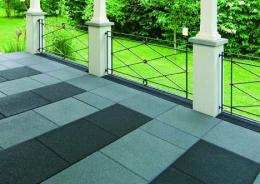Search
Login
Features and technology for laying rubber tiles with your own hands
The construction market offers many innovative and practical materials for arranging a personal plot, one of which is paving rubber tiles.
The rubber crumb coating is very reliable and practical, which allows it to be used for various purposes: designing garden paths, playgrounds, a pool area or a parking lot.
Laying rubber tiles does not cause difficulties, and the benefits of its use are many.
Content
- Characteristics and scope of rubber tiles video video
- Advantages and disadvantages of rubber paving slabs video
- Technology for laying rubber tiles
- Rubber Care
Characteristics and scope of rubber tiles
The main component of rubber paving slabs is rubber crumb recycled from old car tires. Therefore, the finished product has many characteristics (wear resistance, strength, etc.) that are inherent in high-quality tires.

In the manufacturing process, rubber crumb is mixed with binders and pressed into the appropriate plate shapes.
Rubber plates are available in different sizes, shapes and colors. With their different combinations, completely different patterns can be achieved. Masters of landscape design and summer residents actively use this, equipping parks and personal plots.

Rubber paving slabs have the following technical characteristics:
- standard sizes of plates are: 50x50 cm and 35x35 cm;
- tile thickness: 10-45 mm;
- weight up to 7 kg;
- material density 650-800 kg / m3;
- operating temperature range is from +60 to -45 degrees;
- chemical resistance to oil and gasoline, withstands short-term exposure to alkalis and acids;
- water permeability;
- service life up to 10 years.
Paving slabs made of rubber are excellent for different purposes, for example:
- decorating the territory near the pool;

- laying a garden path and sidewalk;

- flooring for a children's or sports ground;

- finishing the floor in the rooms (garage, hallway, gym, bathroom);
- to prevent slipping on the steps and on the porch during rain and winter;
- golf playing area.
Advantages and disadvantages of rubber paving slabs
The wide scope of application of rubber paving slabs is due to the advantages of this material.
- Decorative rubber tiles. Due to the variety of colors and various textures, you can create the most unusual configurations.

- Depending on the operating conditions (outdoors or indoors), you can choose a permeable or impermeable tile.
- Easy to care.
- Ease of installation, dismantling and repair work of the rubber coating. In case of deformation of the site, there is no need to redo the work completely, it is enough to replace the damaged element.
- High durability of a rubber tile: material does not crumble and does not break.
- It does not require special transportation conditions.
- Rubber tile belongs to safety materials, it does not slip and significantly softens impacts when dropped.

- Resistance to temperature fluctuations and sun exposure.
- The surface of the tile does not fade and does not lose its original brightness.
- It has high sound insulation indicators (it is important when finishing the floor in the premises).
- Rubber tile environmentally friendly material.
Despite the significant advantages of rubber paving slabs over other alternative coatings (classic paving slabs and concrete screed), it still has a couple of disadvantages:
- High price. Rubber tile is one of the most expensive coatings used to decorate a personal plot. At the same time, such a price is justified by the duration of operation of the material.
- Fire hazard. Rubber coating should not be placed near sources of fire (barbecue, fireplace). The corner from the fire will burn the rubber plate and may cause a fire. Smoke and fumes from burning rubber coatings are dangerous to human health.
Technology for laying rubber tiles
Rubber tile is a universal finishing material that can be laid on various types of substrates. The features of its laying are explained by the individual characteristics of the tile (thickness, structure) and the properties of the base itself (hard or loose surface).
solid tile installation

Before laying the tiles on a hard surface (asphalt, concrete, wood flooring), it is necessary to level the floor (maximum deviation of 1 mm) and clean it from oil, dust, bulk materials.
The rubber flooring is laid only on a dry surface, therefore, before installation, check the floor for humidity
Preparation of the base of the floor involves the following activities:
- Checking surface moisture. The hygrometer must be brought to the floor and its indications evaluated: the permissible moisture level is not more than 80%.
- You can check the humidity in a folk way: put salt on the floor and cover it with a glass. If after two days the salt remains dry, then the floor is suitable for laying rubber tiles.
- Cement irregularities and defects can be removed with cement-based joints. With significant deviations of the evenness of the floor, it is necessary to dismantle and screed it.
It should be noted that to ensure a normal outflow of rainwater and moisture, the base of the floor must have a tilt angle of at least two degrees
To work, you will need the following tools and materials:
- rubber tile 20 mm thick;
- adhesive for rubber coatings;
- broom or vacuum cleaner;
- sharp strong knife;
- level and ruler;
- container for glue;
- notched trowel;
- a piece of chalk;
- foam sponge and nylon brush;
- soap solution.
To perform the work, it is better to use glue based on polyurethane, since it is such a composition that is used for gluing rubber crumb to plates
An asphalt, concrete or wooden base must adhere firmly to the rubber paving slabs, the installation of which is carried out in compliance with the following rules:
- The temperature of the material and air should be 10-25 degrees.
- Humidity not more than 70%.
- If the surface to be treated subsequently will be in contact with water, then two layers of glue must be applied.
Consider phasing the rubber tiles with your own hands on a solid foundation:
- The surface must be primed.
- Using a roller or spatula, apply a layer of glue.
- If the spread area has the shape of a square, circle or rectangle, then it is better to start laying out the tile from the center.
- The tile must be laid and pressed firmly to the base.

In the process of laying rubber tiles, you must control:
- the gap between the tiles is minimal;
- adjacent coatings are joined as tightly as possible;
- there should be no undulations on the tiled surface;
- there should not be air under the tile;
- glue from the front side of the tile must be removed immediately, since after drying it will be problematic to do this;
- glue is not applied to adjacent tile surfaces.
It is possible to fully use the rubber coating after 48 hours after installation, the glue should dry completely.
laying rubber tiles on a dirt surface
Often, rubber tiles for gardening have to be laid on the ground. In this case, the tile thickness must be at least 30 mm.
Before starting the installation work, it is necessary to properly prepare the basis for creating a three-layer pillow.

- To remove the top layer of soil, to clear a surface of roots and weeds.
- Tamp the base.
- Spread crushed stone layer 70-200 mm high evenly over the ground. The layer thickness will depend on the purpose of the rubber coating: 70 mm is enough for garden paths, it is better to raise the layer to 100 mm for a playground, and 200 mm for a place under a car.
- Cement is mixed with sand in a ratio of 1: 3. Coat a layer of crushed stone with this mixture (layer thickness up to 70 mm). You can lay rubber tiles on sand without adding cement, but it is believed that the first option is more reliable.

Work on creating a rubber flooring or track includes the following steps:
- Extend the cord along the perimeter of the installation site.
- It is better to frame the edges of the paved area with a rubber border that will protect the structure from sprawling and improve the appearance of the garden path or platform.
- Lay rubber tiles alternately, joining them through special bushings.
- Upon completion of the installation of every third row, it is necessary to adjust the accuracy of work (permissible error of up to 10 mm). You can fix the tiles with a wooden or rubber mallet.
- The free space between the plates and the curb must be laid with pieces of plates. You can cut the rubber tile with diamond dusting discs or a sharp knife.

- The finished rubber coating must be tamped with a vibrating plate and sprinkled with plenty of sand. When sweeping, the sand will clog and cover small cracks.
When laying tiles on the ground or sand, you do not need to create a slope, since drainage will occur naturally, water will be absorbed into the ground
Rubber Care
It is not difficult to look after rubber paving slabs. Dry sand, fallen leaves and other debris can be removed from the cover with a broom or vacuumed. If the tile is dirty, it can be washed off the hose or cleaned with a soft brush.
Mold does not form on the rubber coating, it is not affected by fungal spores, and insects and rodents will not damage the surface of the tile.
In winter, snow should be removed from the tiles with a wooden or plastic shovel and a broom. A large area can be cleaned with a snow blower.

Laying of rubber paving slabs is at the same time a simple and non-standard design solution in the arrangement of the garden plot and the adjacent territory. Rubber flooring is very convenient and practical, and its installation does not take much time and does not require professional building skills from the contractor.





